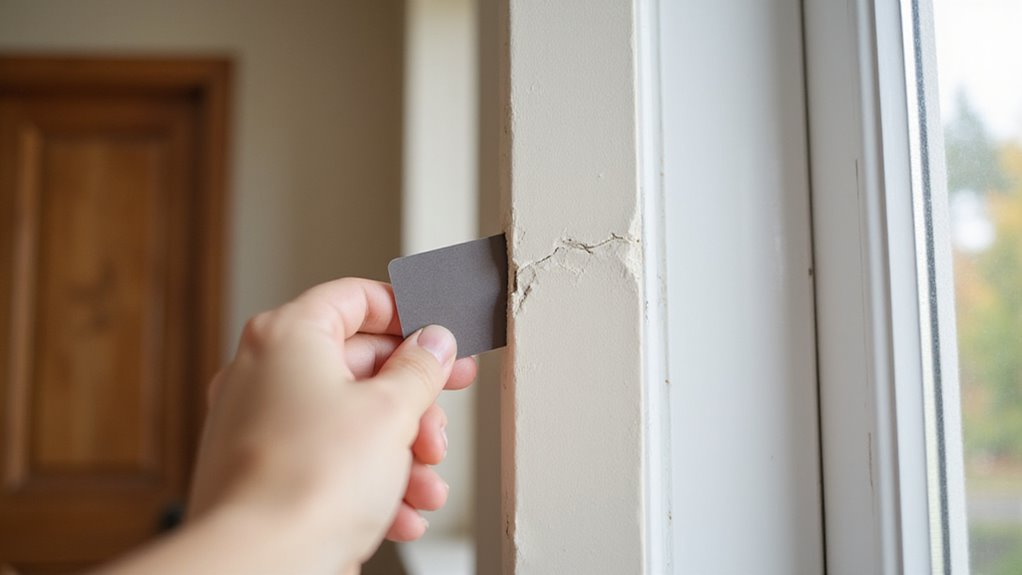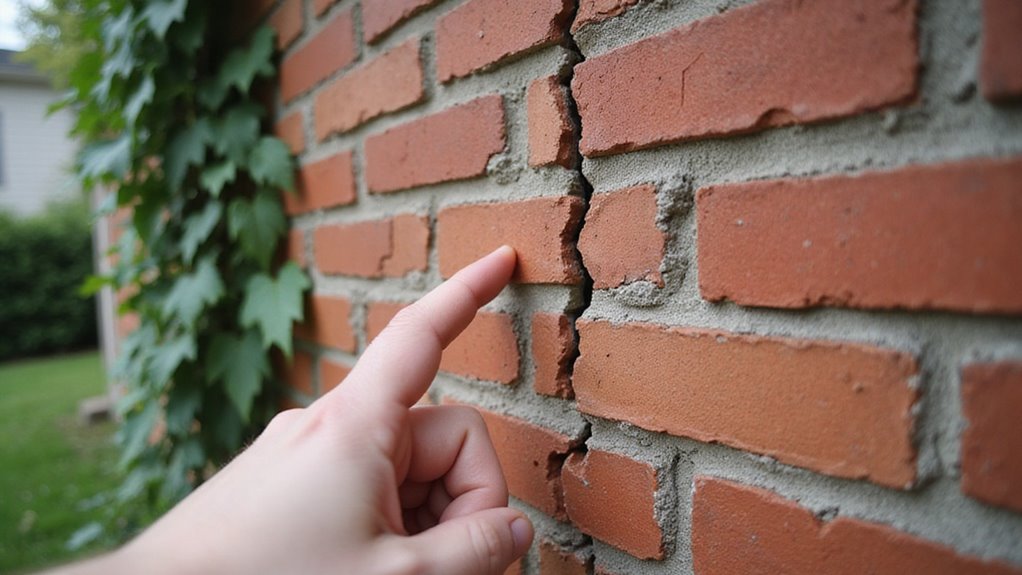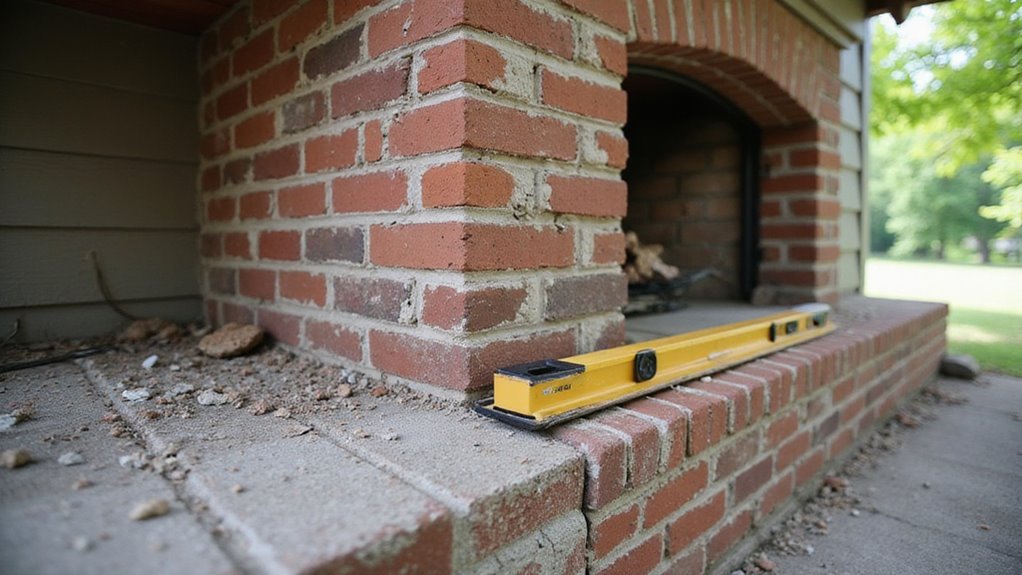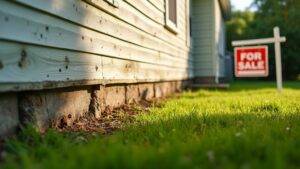If you plan to sell your home, foundation issues can become a major problem. Small cracks or uneven floors often go unnoticed. These signs can lead to bigger issues that may scare off buyers or lower your sale price.
Ignoring foundation warning signs can delay your sale or result in expensive repairs later. Many sellers miss subtle clues until it is too late. Buyers may even walk away if they suspect hidden damage. You can identify foundation issues early by knowing what signs to look for before listing your home.
Simple checks and timely repairs can save you money and stress. Addressing these problems upfront can also make your sale go smoothly. This blog will guide you step-by-step in spotting and fixing foundation issues before selling your home.
Key Takeaways
- Inspect walls, floors, and ceilings for cracks wider than 1/8 inch, especially diagonal or stair-step patterns.
- Check if doors and windows stick, have gaps, or show misaligned frames indicating foundation movement.
- Examine exterior masonry and chimneys for cracks, bowing, or deteriorating mortar as signs of shifting or settling.
- Look for uneven or sloping floors, tilting furniture, or gaps around baseboards that may signal foundation settling.
- Assess basements and crawl spaces for moisture, water stains, white powder (efflorescence), or musty odors indicating water-related foundation issues.
Understanding the Importance of a Solid Foundation

A solid foundation is important because it supports your entire home. It keeps the structure stable and secure. If the foundation is weak, your house can become unsafe. A solid foundation keeps your home stable and secure; without it, the entire structure can become unsafe.
Soil stability matters because unstable soil can cause the foundation to shift or sink. If you ignore this, you may face cracks or uneven settling. Proper soil preparation helps prevent these problems. Before selling, you should also consider the legal requirements and documentation that might be necessary if foundation issues have affected your property’s history.
Foundation materials also play a key role. If you use poor materials, moisture and pests can damage your home over time. Reinforced concrete or treated masonry offer better protection.
A strong foundation prevents major structural damage. It also helps maintain your property value. If you plan to sell your home, start by checking the foundation.
In Virginia, building code compliance is crucial when selling your house, as ignoring foundation issues can lead to legal complications and delays during the sale process.
Checking for Visible Cracks in Walls and Floors
When inspecting your home, pay close attention to the types of cracks you find in walls and floors, as not all cracks signal the same level of concern. You should recognize whether a crack is hairline, vertical, horizontal, or stair-step, since each pattern can point to different underlying issues. By identifying these patterns early, you can better determine if your foundation needs immediate attention or routine monitoring.
Taking the time to document and address cracks thoroughly helps ensure that your disclosures align with legal requirements and can facilitate a faster, smoother closing process. If you’re planning to sell, making sure your disclosures align with Virginia laws is essential to maintain transparency and avoid legal complications.
Types of Common Cracks
Cracks in walls and floors are common and can indicate different problems. Their type, size, and direction help identify possible foundation issues. Knowing these differences helps you spot trouble early.
Hairline cracks are thin and usually caused by normal settling or shrinkage. These are not serious unless they get wider over time. If they do, further inspection is needed.
Vertical cracks often point to foundation settlement. These cracks may be wider at the top or bottom. If you notice this, it could mean the foundation is moving.
Horizontal cracks are more serious, especially in basement walls. They can be a sign of pressure from soil pushing against the wall. If you see these, check for water or soil issues.
Diagonal cracks often start from the corners of doors or windows. These may suggest uneven movement of the foundation. If diagonal cracks appear, it is wise to consult a professional.
Crack Patterns to Watch
Crack patterns in your walls and floors can show foundation problems. Horizontal cracks along basement walls often mean outside soil is pushing against them. If you see these, your foundation may be under stress.
Vertical cracks usually seem less serious but should not be ignored. If these cracks get wider, it could mean the soil under your house is moving. You should watch them over time.
Diagonal cracks, especially if wider at one end, suggest uneven settling. This means one area of the foundation is sinking faster than another. Poor soil or bad foundation materials often cause this.
Cracks near doors or windows can be warning signs. These areas handle more stress, so pay special attention to any changes there. If you plan to sell, always document the size and growth of every crack.
Inspecting Doors and Windows for Proper Function

Next, you should examine every door and window in your home for signs of sticking or difficulty opening and closing. Pay close attention to frames that bind or catch, as well as uneven gaps around sashes and jambs. These issues often indicate that your foundation has shifted and is no longer supporting your home evenly.
Because problems like binding doors and uneven gaps may also signal structural issues caused by fire or other events, it’s essential to rule out any related hidden damage before listing your property. Many homeowners in Broadway choose to work with local team for personalized support when navigating foundation concerns before selling.
Checking for Sticking Frames
Sticking frames can be an early sign of foundation problems. Doors or windows that become hard to open or close may indicate shifting. Homeowners should not ignore these changes.
You should check every door in your house for smooth movement. If a door scrapes the floor or will not latch, the frame might have moved. This could mean the foundation has shifted.
Windows that jam or need extra force to lock can be another warning. If a window frame is out of square, it often points to foundation issues. Early detection helps you fix problems before selling your home.
Assessing Uneven Gaps
Uneven gaps around doors and windows often mean your foundation is shifting or settling. These gaps can lead to bigger problems if ignored. Always check for these signs after inspecting for sticking frames.
Gaps that are wider at the top or bottom could point to a tilted or sinking foundation. If you see light coming through a closed frame, the seal is broken. Locked windows or doors that are hard to use may also show the frame is not square.
If you notice any of these problems, act quickly. Foundation issues can get worse with time. Unrepaired problems may lower your home’s value and affect its safety.
Examining Uneven or Sloping Floors
Uneven or sloping floors can mean there are problems with your home’s foundation. These changes often show up as a tilt or a dip when you walk. They should not be ignored.
You may notice furniture that does not sit flat or objects that roll by themselves. These are warning signs of a possible issue. To ensure a smooth transaction process, having organized documentation and addressing these concerns early can help avoid delays or legal challenges. If you see these signs, check the floor with a level or a marble.
Foundation problems often start when soil under your home shifts. This can happen if soil expands, shrinks, or erodes from poor landscape grading. If you find uneven floors, fix them quickly to stop bigger problems later.
It’s also important to perform a title report to identify if there are any liens or legal claims connected to your property before moving forward with repairs or a sale.
Looking for Gaps Around Window Frames and Doors

Gaps around window frames and doors often mean there is a problem with your home’s foundation. These gaps appear when the foundation moves or settles unevenly. If you notice them, your house may need repairs.
Doors may not close properly if the frames shift. Windows can become difficult to open and close. You should also check if you see daylight through the closed frames. Catching these issues early, by focusing on enhancing curb appeal, can help attract serious buyers and maintain your home’s value.
Cracked caulking or trim around the frames is another warning sign. Misaligned locks or latches can show the frames have moved. If these signs appear, you should document them.
Cracked caulking or misaligned locks may indicate your window or door frames have shifted—be sure to document these warning signs.
These problems can lower your home’s value and make buyers worry. If you notice any of these issues, contact a professional. Early action can prevent bigger problems later.
In addition to structural gaps, home sellers in Virginia are required to disclose known structural issues to potential buyers as part of the legal disclosure process.
Observing Separation Between Walls and Ceilings
You should pay close attention to any visible gaps forming where your walls meet the ceiling, as these can signal underlying foundation movement. Track whether these separations stay the same or if cracks start to widen over time, since progressive changes often point to ongoing structural issues.
Regularly documenting these shifts helps you catch foundation problems early before they worsen. Identifying these issues early can significantly affect your property value and make the selling process much smoother. Early detection of foundation issues can help you address problems promptly and avoid costlier repairs when selling your home in Virginia.
Recognizing Visible Gaps
Visible gaps between your walls and ceilings often mean there is a foundation problem. These gaps show your house might be shifting. If you see them, you should not ignore them.
These gaps can happen because of soil movement or too much moisture. Poor drainage or landscaping near your home can make the problem worse. Check if the gaps are getting bigger or more noticeable.
Sudden or widening gaps may mean your home is still moving. Uneven gap sizes in different rooms could show the settling is not equal. If you notice these signs, consider having your foundation inspected.
Monitoring Widening Cracks
Monitoring widening cracks means checking if cracks in your home are getting bigger over time. If cracks are expanding, this could mean your foundation has a problem. These changes might be caused by shifting soil or settling underneath your house.
You should mark the ends of each crack with a pencil or ruler and write down the date. If you check these marks every week or month, you can see if the cracks are growing. Take clear photos and keep notes as a record.
If the cracks get bigger, you should contact a professional for advice. Good records will help you explain the problem to experts or buyers. Fixing foundation issues before selling your house is important if cracks are widening.
Noting Cracks in Exterior Brickwork or Masonry

Cracks in exterior brickwork or masonry can mean there are problems with your home’s foundation. These cracks should not be ignored. If you see them, you should check your home’s exterior carefully.
Exterior cracks in brickwork or masonry could signal foundation issues—inspect your home’s exterior closely if you notice them.
Look for stair-step cracks, gaps between bricks, or crumbling mortar. These signs may show that your foundation is shifting or sinking. Small exterior cracks can lower your home’s curb appeal, which can be addressed as part of landscaping and maintaining your property. Cracks that get longer or wider over time are especially concerning.
If you notice water draining toward your foundation, this could make the problem worse. Peeling paint near cracks might mean water is getting in through the masonry. Moisture stains or white powder along cracks are also warning signs.
You should pay special attention to cracks wider than 1/8 inch or those running diagonally. Gaps where bricks or blocks do not line up are serious. If you find these issues, consider getting a professional inspection. If you notice these concerns, selling your house as-is for cash is possible, since some buyers are willing to purchase homes in any condition, including those with foundation problems.
Identifying Moisture Issues in Basements and Crawl Spaces
Moisture issues in basements and crawl spaces often point to foundation problems. Signs include damp spots, white powdery residue, or musty smells. These symptoms suggest water is getting inside and may damage your home.
Condensation or water stains on basement insulation are warning signs. If you see these, the insulation may not work well. Water can also weaken your foundation.
In crawl spaces, look for standing water, mold, or rotting wood. Damp crawl spaces can cause structural damage and attract pests. If the vapor barrier is damaged, ground moisture can enter.
Carefully checking these areas helps you find hidden problems early. If you fix issues quickly, you protect your home’s value. This also helps make selling your house much smoother. Sellers in Shenandoah can benefit from cash offers for houses in any condition, making it easier to sell even if you discover foundation or moisture issues.
Assessing the Condition of Chimneys and Fireplaces

When evaluating your home for foundation problems, you should carefully inspect your chimney and fireplace for visible cracks, as these can signal shifting or settling. Check if the fireplace remains properly aligned with surrounding walls, since misalignment often points to structural movement. Examine mortar joints for signs of crumbling or separation, which can indicate ongoing foundation stress.
Inspecting Visible Cracks
Visible cracks around your chimney or fireplace can signal foundation problems. These cracks are often early signs of soil or drainage issues. If you see them, your foundation may be at risk.
Horizontal or stair-step cracks in chimney bricks can mean the soil is moving. Widening gaps between the fireplace and walls often point to issues like tree roots or bad grading. Cracks that come back after repairs show the problem may be getting worse.
Careful inspection helps you find these issues early. If you notice any of these cracks, you may need to check your landscaping and foundation. Early action can prevent bigger and more expensive problems.
Checking Fireplace Alignment
Fireplace alignment can show if there are foundation problems. Stand back and check if the fireplace looks straight or if it leans. A tilted or separated fireplace often means the foundation has moved.
Check where the chimney meets the roof for gaps or uneven lines. These signs can mean the chimney is unstable. Use a level on the hearth and mantel to see if they are flat.
If you find any misalignment, take notes and photos. Changes in alignment can get worse with time. Consider a professional inspection if problems appear before selling your home.
Examining Mortar Deterioration
You can spot deeper chimney or fireplace problems by looking at the mortar. Damaged mortar often hints at bigger structural concerns. If you see issues with the mortar, it may be time to act.
Crumbling or missing mortar means the structure could be shifting. Gaps in the mortar joints might show settling or a weak foundation. Efflorescence or moisture stains suggest water is getting in and making things worse.
If you fix damaged mortar early, you can prevent expensive repairs later. Quick action also helps keep your home safe and strong. Buyers will feel more confident in your property’s condition.
Watching for Bowed or Bulging Walls
Bowed or bulging walls in your basement or crawl space are signs of possible foundation problems. These walls may curve or push outward. You should not ignore even small changes.
Soil pressure is a common cause of bowed walls. Poor landscaping that directs water toward your home can make the problem worse. Cracks in the interior paint may also appear if the wall is shifting.
Horizontal or stair-step cracks are especially serious. If you use a level, you can check if the wall is straight. If you notice leaning, you should take action quickly.
Early detection of bowed or bulging walls helps prevent bigger foundation issues. If you fix these problems early, you protect your home’s value. These warning signs are important and should not be overlooked.
Inspecting the Foundation Perimeter for Damage
Check your home’s foundation perimeter to find early signs of damage. A careful walk around the base can reveal visible problems. If you spot issues early, you can avoid serious repairs later.
Look for cracks or gaps in the foundation. Horizontal or stair-step cracks may mean the ground is shifting. If cracks are getting wider, soil movement could be the cause.
Notice any separation between the foundation and outside walls or steps. These gaps suggest uneven support under your home. If you see this, your foundation may need attention.
Watch for water pooling or damp ground next to the foundation. Persistent moisture often signals poor drainage. If left unfixed, water can damage the foundation faster.
Monitoring for Persistent Sticking or Jammed Doors
Sticking or jammed doors can be early signs of foundation problems. A shifting foundation may cause door frames to move out of place. This can make it hard for doors to close or open smoothly.
Check the door hinges for looseness or gaps. If hinges are pulling away from the wood, foundation settling might be the cause. Cracks in the paint around the frame can also show movement.
If door issues continue after adjustments, you should not ignore them. Persistent problems may mean your foundation needs inspection. Consider calling a professional before selling your home.
Recognizing Musty Odors and Mold Growth
Musty odors and mold growth often mean there is too much moisture indoors. If you smell a damp odor or see mold, you may have a moisture problem. These issues can point to poor ventilation or water getting inside your home.
You should watch for certain warning signs. These include a musty smell, especially after rain or during humid days. Mold patches or damp spots on walls and floors are also signs.
If you see condensation on windows or walls, it may mean you have too much indoor moisture. Fixing ventilation and lowering humidity can help prevent mold growth. Taking action early can stop bigger problems from developing.
Deciding When to Call a Professional for Evaluation
You should call a professional if you see cracks in walls or uneven floors. Sticking doors and windows are also warning signs. A timely inspection helps prevent bigger issues.
Musty smells or visible mold may mean there are deeper foundation problems. A licensed inspector can check if the damage is more than just cosmetic. If there is poor drainage or soil slopes toward your house, mention this during the evaluation.
Water from a damaged roof can harm your foundation. Roofing inspections may reveal leaks that need quick repairs. Addressing these problems early saves money later.
Fixing foundation issues before selling your home increases buyer confidence. Early action helps make the selling process smoother. An expert’s assessment can reassure both you and future buyers.
Conclusion
If you carefully check for foundation issues before selling, you can avoid unexpected problems during the sale process. Early detection of cracks, gaps, or moisture helps protect your property’s value. If you notice anything unusual, you should always consult a professional.
When foundation problems are present, selling your house may seem difficult. If you prefer a simple process, we buy houses for cash in any condition. This can save you time and prevent extra expenses on repairs.
If you want a stress-free sale, we encourage you to contact Align Real Estate Solutions today. We are ready to help with your unique situation. Let us make your selling experience smooth and straightforward.
Author
-

Zach Koops is co-founder and Real Estate Success Manager at Align Real Estate Solutions, serving homeowners across Virginia since 2024. With a passion for real estate and a heart for people, Zach has built his career around helping sellers navigate tough situations—foreclosure, inheritance, relocation, repair-overload—with clarity and compassion. He’s known for being straightforward, steady under pressure, and deeply invested in relationships. Outside of work, he spends his time as a husband and father, enjoys the outdoors in Shenandoah Valley, loves singing on stage, and constantly seeks growth through reading and new experiences.









